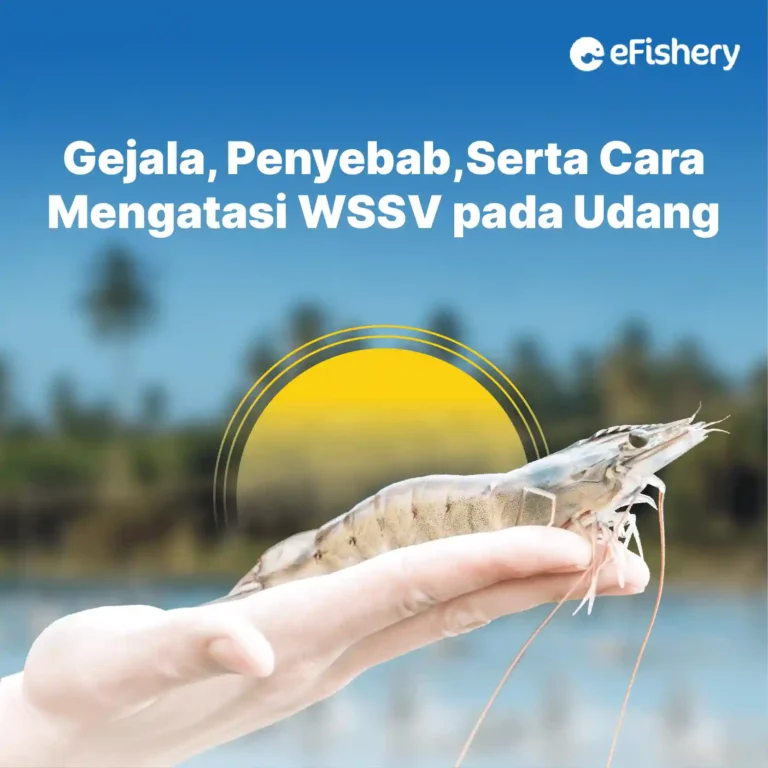Artikel Ini Telah Direview Oleh:

Laksono Radityo
Praktisi Budidaya Udang
White Spot Syndrome Virus (WSSV) is a very virulent pathogen and very difficult to cure when it attacks shrimp. WSSV in shrimp can cause death up to 100% within 3-10 days since clinical symptoms appear.
WSSV can only be anticipated with preventive measures, such as selecting superior seeds and good cultivation management. Therefore, Mr/Mrs Farmers need to take precautions, namely monitoring the presence of WSSV in shrimp ponds.
Come on, read this article to find out more information about the symptoms, causes, and how to deal with WSSV in shrimp!
What is WSSV?
White Spot Syndrome Virus (WSSV) is a pathogen that causes white spot disease (White Spot Disease) in shrimp. Usually, farmers are more familiar with the term WS disease.
WSSV was first detected in Taiwan in 1992, then spread to Southeast Asia to Latin America. The initial spread of WS in Indonesia was in 1994 on the north coast of East Java, Central Java, West Java, and South Aceh.
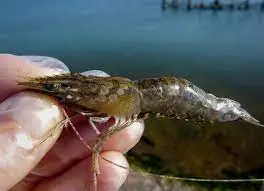
WSSV is ovoid in shape and has a viral envelope 210-420 nm long and 70-167 nm wide. WSSV can easily spread to the body of the shrimp through the hemolymph which forms horizontal stripes with a width of 20 nm. Shrimp infected with WSSV will have white spots with a diameter of 0.5-2 mm on the head.
When the infection gets worse, these white spots can spread all over the shrimp's body. In addition to white spots, the body of a shrimp infected with WSSV will turn pale reddish. Not only that, the shrimp will also become weak and their intestines empty because they have no appetite. Shrimp infected with WSSV will experience damage to the cells of the hepatopancreas, stomach, gills and intestines.
The following are triggers for WSSV disease in shrimp:
1. Poor Water Quality
WS disease appears to be caused by environmental conditions, hosts, and pathogens. When there is a significant decrease in water quality, the shrimp will experience stress and their immune system decreases, so that the shrimp will be susceptible to viruses.
The following are parameters that increase the pathogenicity of the virus:
- Ammonia > 1 mg/l
- Nitrites > 1 mg/l
- Temperature fluctuation
- pH fluctuation
- DO < 3 mg/l
- TOM > 80 ppm
- Salinity changes quickly
- High total vibrios
2. Poor Feed Management
Excessive feeding, known as overfeeding can increase organic matter and trigger an increase in toxic compounds, so that shrimp will be susceptible to disease.
3. Pond biosecurity is not good
The application of biosecurity is a very important process in shrimp farming. One way is by sterilization which is useful for killing disease-carrying pathogens. If this process is not carried out properly, disease will easily appear and infect the shrimp. In addition, fry that do not have an SPF certificate (Specific Pathogen Free) are susceptible to disease. For this reason, you are strongly advised to choose fry with SPF.
WSSV attacks shrimp at all stages, both fry and mature shrimp. In addition, WSSV can cause total mortality of up to 100% of shrimp populations in ponds. Infection will occur for 2-10 days after symptoms appear. Meanwhile, mass mortality occurred 3-10 days after the shrimp were infected.
Symptoms of WSSV Disease
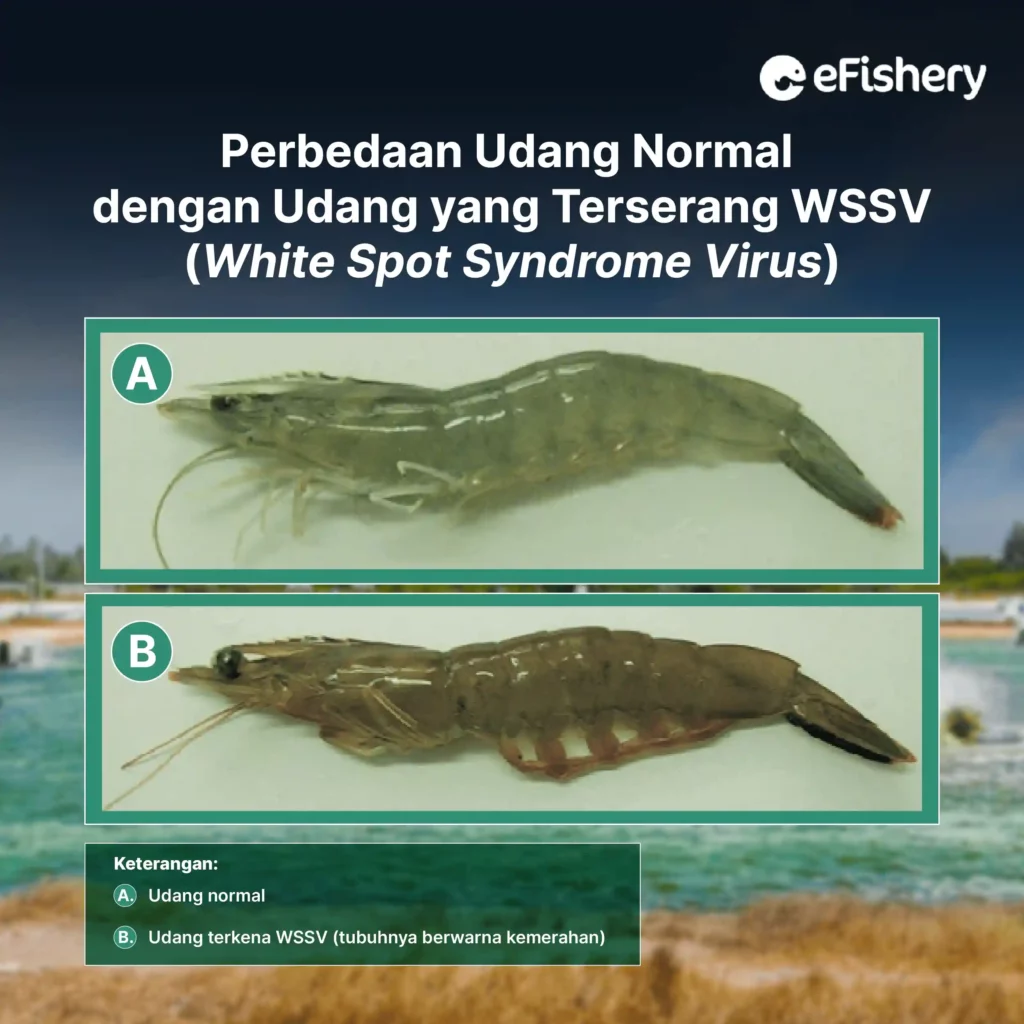
WS disease occurs due to stress on shrimp due to environmental factors, such as sudden changes in salinity, temperature changes significantly, low DO, and high concentrations of ammonia in ponds.
These environmental changes can cause the shrimp's immune system to decrease. This is because the energy that should be used for growth and maintaining endurance decreases due to the process of osmoregulation.
Osmoregulation is an effort made by vannamei shrimp to control the balance of water and ions in the body with its environment. Disruption of osmoregulation in shrimp can result in slow growth of shrimp. This is due to the dynamics of water salinity which changes significantly.
WS causes white spots on the carapace of shrimp which originate from the accumulation of abnormal calcium salts. Shrimp infected with WSSV will show the following symptoms:
- Looks dying
- There are white spots in the form of circles
- There is a reddish to brown color all over the body of the shrimp
- Dirty body covered with moss
- Before being infected with WSSV, shrimp appetite increased. After that, the shrimp's appetite dropped significantly
- Enlarged hepatopancreas
- Response to slow feed and empty gut
For more details, you can see pictures of WSSV infected shrimp in the table below!
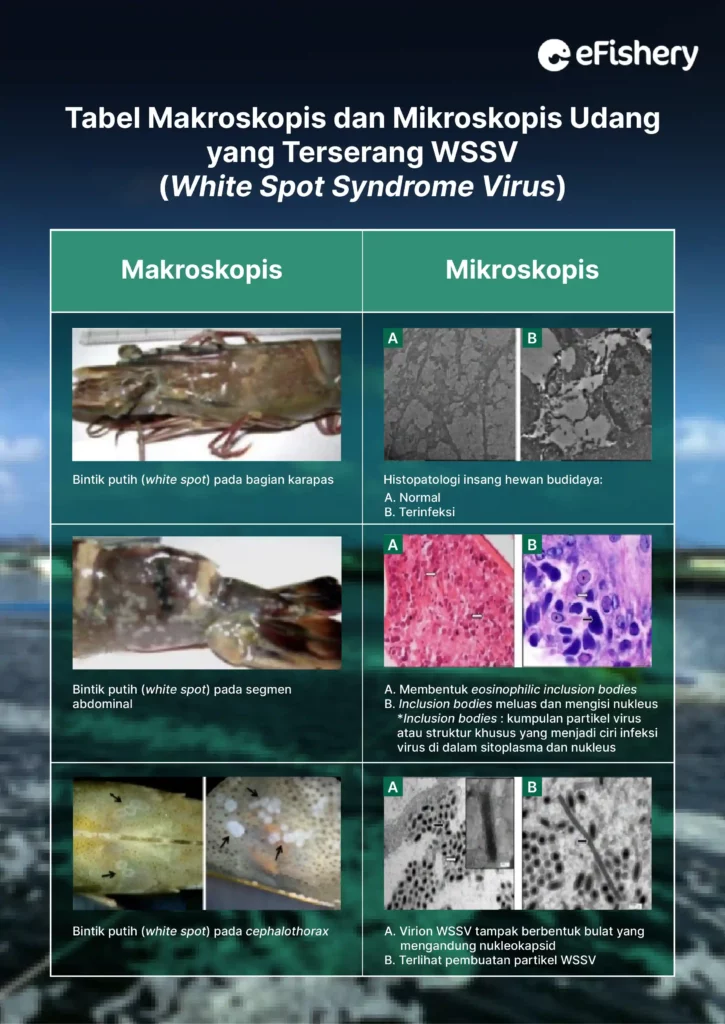
If shrimp are found to be very active in eating and often on the surface of the water, it is necessary to watch out for the possibility of WSSV attack. Shrimp infected with WSSV usually grow very fast, which can reach sizes of up to > 4 grams at the age of one month, whereas normal shrimp in ponds are 2-3 grams at the age of one month.
White spots usually start from the head of the shrimp, then spread to the body. White spot disease usually appears on DOC 30-70 days. Therefore, you must immediately treat the disease when abnormal growth (too big) shrimp is found.
After you know the symptoms of WSSV disease, you need to know the development of WSSV which includes three stages, as follows:
- Incubation (Early Stage):
- Shrimp infected with WSSV will show or not show clinical symptoms
- Infected shrimp may still show normal swimming activity
- Transition:
- White spots appear on the carapace and other clinical symptoms appear
- Onset (Late Stage):
- Infected shrimp will die within a few hours to days
Shrimp infected with WSSV will experience changes in behavior such as decreased swimming activity, swimming directionally, and often swimming only on one side of the pond. In addition, the shrimp will tend to cluster at the edge of the pond and swim on the surface.
WSSV can be transmitted through the vertical route, which spreads through the broodstock to the shrimp fry. Other transmission through the horizontal route, namely through water and direct contact with WSSV-infected shrimp.
In addition, WSSV can be transmitted through bird intermediaries from one pond to another. The method of transmission is that birds eat sick shrimp swimming on the surface of ponds and the remaining shrimp that are not eaten by birds fall into other ponds.
How to Prevent and Overcome WSSV
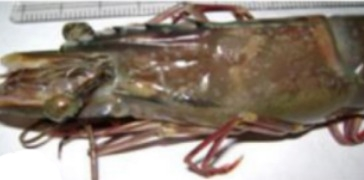
White spot disease in shrimp needs to be prevented early on, so as not to trigger cultivation problems such as crop failure. WS disease in shrimp is difficult to cure, but you can take steps to prevent this disease, including:
1. Proper Feed Management
To maintain the quality of pond water always in optimal condition, you need to do feed management to avoid overfeeding and decreasing water quality. Here are shrimp feed management tips that you can use as a reference:
- Determine the Amount of Feed Based on Age (DOC) Shrimp
Determination of the amount of feed given to shrimp must be based on the age of the shrimp. For example, for shrimp with DOC < 30 days, feeding can be done with blind feeding, because feed requirements have not been calculated accurately.
Meanwhile for DOC > 30 days, you need to calculate the amount of feed given according to the needs of the shrimp. The calculation of the amount of feed is based on survival rates, average shrimp body weight, and feeding rate.
- Frequency of Feeding
In the shrimp body, the feed consumed will be processed for 3-4 hours. You can use this as a benchmark in determining the frequency of feeding each day. You can provide feed 3-5 times a day according to the shrimp stage.
- Make sure the method of feeding is done correctly
Feeding can be done in two ways, namely direct distribution (manually) and with assistance autofeeder. Then, you can monitor shrimp appetite using anco. The trick is to put anco filled with shrimp feed every 2-3 hours after feeding.
2. Environmentally Friendly Prevention
Environmentally friendly disease prevention is by using immunostimulants and vitamins. The benefit is that it can restore the health of shrimp due to environmental changes (reducing stress), increase metabolism, and improve the immune system and growth.
You can also apply probiotics to the environment (pond bottom and water) and feed to improve shrimp health, improve the digestive system, improve pond water quality, and reduce mortality due to reduced virulence of disease-causing bacteria and viruses.
Tak hanya itu, Bapak/Ibu dapat melakukan aplikasi berupa bahan sterilisasi yang lebih ramah lingkungan dan tanpa residu dengan dosis rendah. Another prevention is that you need to carry out routine circulation and mineral applications according to weather conditions.
3. Appropriate Biosecurity Application
Biosecurity is a rule applied to minimize the risk of disease transmission in shrimp ponds. Biosecurity that you can do is by removing silt in ponds, liming, and draining the system between cultivation cycles. This can eradicate WSSV carrier vectors such as crabs, polychaete worms, and other benthic species.
Not only that, what biosecurity can do to prevent WSSV is that you can build a fence by adding a channel equipped with a biofilter. The fence serves to prevent entry carrier or illness.
You can make a fence made of plastic or nets that are placed around the pond to prevent other animals from entering. In addition, the water used for shrimp farming needs to be collected or deposited in a reservoir first so that the quality is better.
4. Ensure Shrimp Benur is Disease Free
WSSV can come from the water used or even emerge from the spread of shrimp fry. For this reason, you need to ensure that the fry are healthy and of good quality.
Superior and certified fry are one of the steps to success in cultivation. The following are the characteristics of healthy fry:
- The SPF fry (Specific Pathogen Free) against WSSV disease
- The fry antenna is intact and not broken, and can be opened and closed
- Body shape straight and slender
- Shiny eyes
- Bright color and no spots on the skin
- The tail is not deformed and unwrapped
5. Routine Checking
You need to carry out routine checks on the pond. The method is to measure water quality every day, monitor shrimp while in anco, and periodically sample shrimp to see the condition of the shrimp's body.
After you know how to prevent WS disease in shrimp, you also need to know how to deal with WSSV. This is because if there is one shrimp infected with WSSV, the other shrimp have the potential to be infected and eventually experience mass death.
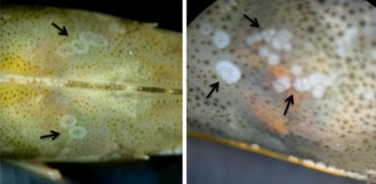
Before there is a loss in the cultivation that you live, you are advised to know strategies to deal with WSSV, including:
- Early Identification
The first step in dealing with WSSV is to check it as an early identification. You can check in the laboratory with PCR, if you routinely carry out checks it will detect WS disease or other diseases in shrimp more quickly.
- Early Harvest
You can harvest earlier if the white spot disease has not spread widely. Harvesting the shrimp prematurely is said to be an alternative solution, compared to Mr/Ms letting the shrimp live but leading to mass death.
- Pond Sterilization
After you have harvested, you need to sterilize the pond area so that WSSV does not attack the shrimp again. This sterilization process is called eradication, that is, you need to add 30 ppm of chlorine to a pond that has been filled with water.
You can bury or burn dead shrimp during the harvesting process. This is useful for preventing the spread of disease. Apart from sterilizing ponds, you must also sterilize cultivation equipment that has the potential to become a place for the emergence of the WSSV virus.
Prevent Shrimp Death from WSSV with Aquaculture Consultation at eFarm
Need Help Regarding Shrimp Cultivation Business?
Fill in your personal data in the following form. Our team will immediately contact you via the number cellphone attached. Make sure the data entered is correct.
One of the biggest problems in shrimp farming is that shrimp are easily exposed to bacteria and disease outbreaks, one of which is WSSV. So, you need to carry out maintenance properly and be extra careful.
You can prevent the shrimp being cultivated from being exposed to disease outbreaks, thus minimizing deaths during the cultivation process. How to? Now, Mr / Mrs Farmers have the opportunity to get free assistance in managing cultivation, especially shrimp ponds.
Mr / Ms can consult about the problem of shrimp farming to experts through special features, namely Cultivation Consultation from eFarm! There are many professional aquaculture experts and shrimp farmers who are ready to discuss with you in person on line.
Come on, hurry up downloads eFarm for FREE, right now!

Laksono Radityo - Praktisi Budidaya Udang
Berpengalaman sebagai asisten riset perikanan dan teknisi tambak udang. Saat ini aktif sebagai Technical Support Online di eFishery
Questions Regarding WSSV in Shrimp
WSSV in shrimp is a virus that causes white spot disease (White Spot Disease) in shrimp. This virus is considered virulent and difficult to cure because it can cause mass death of up to 100%.
- Dey BK, Dugassa GH, Hinzano SM, Bossier P. 2019. Causative agent, diagnosis and management of white spot disease in shrimp. 12(2): 822-865. DOI 10.1111/raq.12352
- Lilisurani. 2020. Viral Disease Attack on Shrimp in Ponds Without Showing Clinical Symptoms. Journal of Fisheries Science. 9(1): 25-32.
- Ramos-Carren S, Valencia Yanez R, Correa Sandoval F, Ruız Garcıa N, Dıaz Herrera F, Giffard Mena I. 2014. White spot syndrome virus (WSSV) infection in shrimp (Litopenaeus vannamei) exposed to low and high salinity. Arch Virol. 159(9): 2213-2222. DOI 10.1007/s00705-014-2052-0
- Suprapto H and Kartika Y. 2012. Virus Monitoring with the PCR Method (Polymerase Chain Reaction) on the North Coast of East Java. Fisheries and Maritime Scientific Journal. 4(1): 65-71.
- Yanto H. 2006. Diagnosis and Identification of Diseases of Shrimp From Intensive Ponds and Seed Pantries in West Kalimantan. Journal of Science and Technology Research. 7(1): 17-32.
